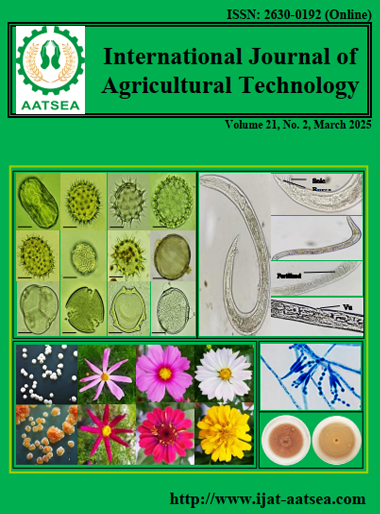Biodegradation of dyes in textile wastewater using local fungal isolates
Main Article Content
Abstract
Textile wastewater contains dyes and excessive amounts of nitrogen, phosphorus, and metal compounds, as well as organic pollutants that. Wastewater also contains chemical wastes that are not biodegradable that can cause infectious disease. The chemical and biological waste in sewage and water must be broken down before it is deposited to the soil and environment. The extensive use of dyes often causes pollution problems. The presence of very low concentrations of dyes in large water bodies is shown to be highly visible and indisputable and also reduced light penetration and photosynthesis. In addition some dyes either toxic or mutagenic and carcinogenic. In this study, waste water was treated by microbial isolates from Egyptian soil. The potent fungal isolate used for the degradation of the excess dye used in textile industry and waste water. The study investigated the biodegradation process under different growth conditions. Different parameters were involved , dyes concentration, inoculum size incubation time, temperature, and growth medium. The decolorization efficiency for these dyes were investigated. Reactive yellow 145 is used the maximum wave lengthof 475. These isolates were belong to species such as Aspergillus niger, A.ochraceous, Mucor recemosus , Penicilluim notatum and P. chrysogenium. After they screened for optimum efficiency and the condition for temperature and pH which optimized and the effectiveness of biodegradation process. The results showed that the maximum decolorization 65.77% was obtained at pH 6.5, fermentation time of 6 day, dye concentration of 90mg/h, and agitation rate 200 rpm.at 30C0.
Article Details

This work is licensed under a Creative Commons Attribution-NonCommercial-NoDerivatives 4.0 International License.
References
Ali, N. F. and El- Khatib, E. M. (2010). Modification of Wool Fabric to Improve Its Dyeability. Journal of Natural Fiber, 7:276-288.
Ali, N. F. and El-Mohamedy, R. S. R. (2012). Microbial decolourization of textile waste water. Journal of Saudi Chemical Society, 16:117-123.
Ali, N. F. and EL-Mohamedy, R. S. R. (2016). Evaluation of Moringa oleifera seed extract coagulation in removal of some dyes in textile wastewater. International Journal of ChemTech Research, 9:538-545.
Birhanli, A. and Oznen, M. (2005). Evalution of the toxicity and teratogenity of six commercial textile dyes using the frog embryo teratogenesis assay-Xenopus. Drug and Chemical Toxicology, 28:51-65.
Camarero, S., Ibarra, D., Martínez, M. J. and Angel, T. M. (2005). Lignin derived compounds as efficient laccase mediators for decolourization of different types of recalcitrant dyes. Applied Environmental Microbiology, 71:1775-1784.
Degon, E. E., Yesilada, E., Ozata, L. and Yologiu, S. (2005). Genotoxicity testing of four textile dyes in two crosses of Drosophila using wing somatic mutation and recombination test. Drug and Chemical Toxicology, 28:289-301.
Garg, V. K., Kumar, R. and Gupta, R. (2004). Removal of malachite green dye from aqueous solution by adsorption using agro-industry waste: A Case Study of Prosopis Cineraria. Dyes and Pigments, 62:1-10.
Geertanjali, R., Adyasa, B., Sudip, K. and Sangeeta, R. (2021). Degradation of dyes by fungi: an insight into mycoremediation BioTechnologia, 102:445-455.
Gong, R., Ding, Y., Mei, L., Yang, C., Liu, H. and Sun, Y. (2005). Utilization of powdered peanut huil as biosorbent for removal of anionic dyes from aqueous solution. Dyes and pigment, 64:187-192.
Hassan, M. M., Alam, M. Z. and Anwar, M. N. (2013). Biodegradation of textile azo dyes by bacteria isolated from dyeing industry effluent. International Research Journal of Biological Sciences, 2:27-31.
Kanmani, P., Kumar, S. R., Yuvraj, N., Parri, K. A., Pethikumar, V. and Arul, V. (2011). Microbial decolorization of synthetic dyes and reactive dyes of industrial effeuents by using novel fungaus Asprtgillus proliferans. Water Environment Research, 83:2099-2106.
Kim, T-H., Lee, Y., Yang, J., Lee, B., Park, C. H. and. Kim, S. (2004). Decolorization of dye solution by a membrane bioreactor (MBR) using white-rot Fngi. Desalination, 168:287-293.
Mian, A. H., Qayyum, S., Zeb, S., Fatima, T., Jameel, K. and Rehman, B. (2024). Exploring indigenous fungal isolates for efficient dye degradation: A comprehensive study on sustainable bioremediation in the total environment. Environmental Technology & Innovation, 34:103615.
Mohamed, F. A., Ali, N. F., EL-Mohamedy, R. S. R. and Hebeish, A. A. (2014). Biodegredation of reactive and reactive disperse dyes by Aspergillius nigar. Bioremediation & Biodegradation, 5:1-5.
Nigam, P., Armour, G., Banat, I. M., Singh, D. and Marchant, R. (2000). Physical removal of textile dyes effluents and solid-state fermentation of dye-adsorbed, agricultural residues. BioresourceTechnology, 72:219-266.
Park, C., Lee, M., Lee, B., Kim, S. W., Chase, H. A., Lee, J. and Kim, S. (2007). Biodegradation and biosorption for decolorization of synthetic dyes by Funalia trogii. Biochemical Engineering Journal, 36:59-65.
Salar, R. K. and Kumar, J. (2012). Evaluation of different Aspergillus species for degradation of a reactive dye, Orange M2R. Annals of Biological Research, 3:4491-4496.
Wesenberg, D., Kyriakides, I. and Agathos, S. N. (2003). White-rot fungi and their enzymes for the treatment of industrial dye effluents. Biotechnology Advances, 22:161-87.


